Visiting CERN
December 07, 2022
It's been about 14 years ago since I last visited CERN. The city of Geneva has appeared a few times on past itineraries, but this was the first time since the "LHC incident" in September 2008 that I visited the CERN Meyrin site. Some things have changed, but many things did not, and it was pretty amazing to find myself walking the same shortcuts through an all-familiar maze of interconnected buildings. While the main motivation for my visit was to discuss our contributions to the construction of CMS's "MIP Timing Detector" (MTD), or rather its Endcap Timing Layer (ETL), it was a great opportunity to attend some of the meetings that took place in the context of the CMS Week and visit "Point 5," the experimental site for the CMS detector to see in-person how the installation efforts in a few years will look like.
It was also a great opportunity to meet old friends (Tapan!) going back to my days as an undergraduate and graduate student at the WA93 and WA98 experiments, respectively.
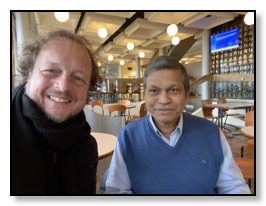
Unfortunately, the Netherlands lost that same week from Argentina in the quarter finals of the World Cup ...
It was also a great opportunity to meet old friends (Tapan!) going back to my days as an undergraduate and graduate student at the WA93 and WA98 experiments, respectively.

Unfortunately, the Netherlands lost that same week from Argentina in the quarter finals of the World Cup ...
Strangeness in QuarkMatter 2022
June 17, 2022
At the 20th International Conference on Strangeness in Quark Matter, Zaochen Ye was invited to present at one of its plenary sessions an overview of thermal dilepton measurements in heavy-ion collisions The conference typically focusses on experimental an theoretical developments with respect to strange and heavy-flavored quarks in high-energy heavy-ion collisions as well as in astrophysical phenomena. Dilepton measurements essentially straddle this range of topics as such measurements include decays of phi mesons (strangeness), contributions from charm mesons through J/psi and weak D-meson decays. Temperature measurements extracted from dilepton measurements further more give insight to the conditions inside a QGP, which is a state of matter that arose early after the Big Bang and potentially in neutron-star collisions.
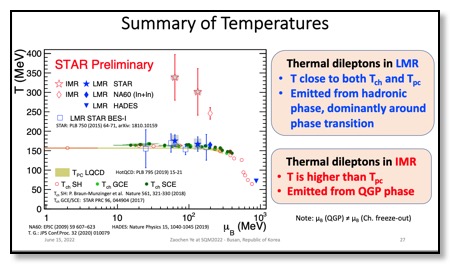
(slide from Zaochen Ye's SQM'22 plenary presenation, summarizing temperature measurements)

(slide from Zaochen Ye's SQM'22 plenary presenation, summarizing temperature measurements)
QuarkNet 2022 Summer Workshop for Teachers
June 11, 2022
With the support of the QuarkNet leadership and Rice's Physics & Astronomy department the yearly QuarkNet workshop took place in June 2022.
Over the span of a full week from June 6-10, we were able to about a dozen teachers from various campus across Greater Houston. Equally exciting is that we saw a record number of five QuarkNet fellows travel to Houston to lead a great set of mini-workshops as well as a couple of fellows that joined remotely. A special shout-out goes to Houston center's lead teacher Mary Yarbray and QuarkNet fellow Shane Wood who both have been instrumental in bringing together an exciting program and great group of enthusiastic teachers.
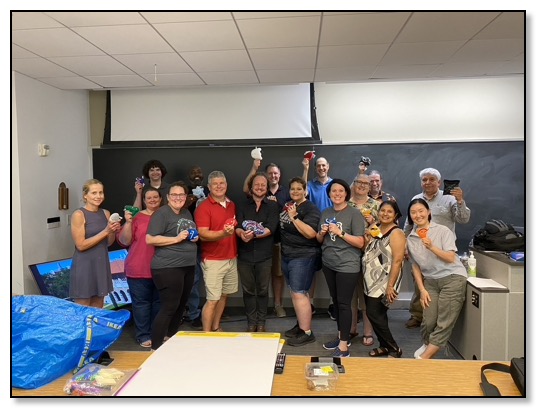
This year's program saw three components, all new, that included a coding workshop, a neutrino workshop, and a brand-new Higgs@10 workshop on the imminent 10yr anniversary of the discovery announcement of the Higgs boson. With the introduction to coding, using Python-based code in Jupyter notebooks, the teachers learned about exciting new ways in which students could deeper engage with physics measurements (or simulations). The neutrino workshop further build on top of this by pulling in real MINERvA data and manipulating these data to learn more about the observation of neutrino oscillations. Finally, the Higgs@10 workshop allowed everybody to re-familiarize eachother with the powerful iSpy environment in which teachers and students can pull in real CMS or ATLAS data. For this workshow, these curated data sets provided great opportunities to observe the Higgs peak arise from an analysis of 4-lepton LHC p+p events.
In addition to the mini-workshops, faculty and scientists from both UH and Rice gave hour-long lectures on a range of topics that included an overview of exciting new detector upgrades in anticipation for LHC Run3 (prof. Ecklund), how heavy-ion collisions and neutron-star collisions related (prof. Ratti), what we've learned in the past 10 years since the Higgs discovery (prof. Acosta), and how nuclear physics is applied in radiation therapies (prof. Yepes).
We are very grateful to the QuarkNet leadership for their support - specifically to Shane, Chris, Adam, Mike-1, Mike-2, Maria, and Ken! We thank the Rice Physics & Astronomy Dept. for its in-kind contributions, not in the least providing lunch to all that attended (thank your Barbara!).
Over the span of a full week from June 6-10, we were able to about a dozen teachers from various campus across Greater Houston. Equally exciting is that we saw a record number of five QuarkNet fellows travel to Houston to lead a great set of mini-workshops as well as a couple of fellows that joined remotely. A special shout-out goes to Houston center's lead teacher Mary Yarbray and QuarkNet fellow Shane Wood who both have been instrumental in bringing together an exciting program and great group of enthusiastic teachers.

This year's program saw three components, all new, that included a coding workshop, a neutrino workshop, and a brand-new Higgs@10 workshop on the imminent 10yr anniversary of the discovery announcement of the Higgs boson. With the introduction to coding, using Python-based code in Jupyter notebooks, the teachers learned about exciting new ways in which students could deeper engage with physics measurements (or simulations). The neutrino workshop further build on top of this by pulling in real MINERvA data and manipulating these data to learn more about the observation of neutrino oscillations. Finally, the Higgs@10 workshop allowed everybody to re-familiarize eachother with the powerful iSpy environment in which teachers and students can pull in real CMS or ATLAS data. For this workshow, these curated data sets provided great opportunities to observe the Higgs peak arise from an analysis of 4-lepton LHC p+p events.
In addition to the mini-workshops, faculty and scientists from both UH and Rice gave hour-long lectures on a range of topics that included an overview of exciting new detector upgrades in anticipation for LHC Run3 (prof. Ecklund), how heavy-ion collisions and neutron-star collisions related (prof. Ratti), what we've learned in the past 10 years since the Higgs discovery (prof. Acosta), and how nuclear physics is applied in radiation therapies (prof. Yepes).
We are very grateful to the QuarkNet leadership for their support - specifically to Shane, Chris, Adam, Mike-1, Mike-2, Maria, and Ken! We thank the Rice Physics & Astronomy Dept. for its in-kind contributions, not in the least providing lunch to all that attended (thank your Barbara!).
RHIC & AGS Users' Meeting 2022 Merit Award
June 11, 2022
Congratulations to Zaochen Ye!
At the 2022 virtual RHIC and AGS Users' Meeting, Zaochen received a prestigious Merit Award from BNL's ALD for Nuclear and Particle Physics, dr. Haiyan Gao. He was honored for “his dedication to STAR time-of-flight detector operation and calibration, and breakthrough analysis of dielectron continuous spectra related to the QGP (quark-gluon plasma) radiation.”
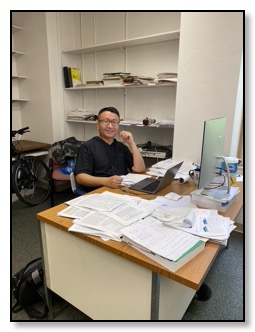
(picture: Zaochen Ye in his office, right before the virtual ceremony)
At the 2022 virtual RHIC and AGS Users' Meeting, Zaochen received a prestigious Merit Award from BNL's ALD for Nuclear and Particle Physics, dr. Haiyan Gao. He was honored for “his dedication to STAR time-of-flight detector operation and calibration, and breakthrough analysis of dielectron continuous spectra related to the QGP (quark-gluon plasma) radiation.”

(picture: Zaochen Ye in his office, right before the virtual ceremony)
Heaps Prize 2022
May 09, 2022
The Heaps Prize is one of the top awards with which the Physics & Astronomy department each year honors an undergraduate physics student on the basis of excellence in a recent research project, often one leading to the senior thesis. The Distinction in Research in Physics and Astronomy is given for a research accomplishment of exceptional quality, as judged by a committee of faculty based on one or more scientific documents describing a contribution to physics, astronomy, or related field. The recipient of both honors this year is Jaanita Mehrani for her excellent work in our group on "Hydrodynamics calculations of Beam Energy Scan Au+Au data, taken by the STAR experiment." I am not sure any pictures were taken but if there are I will update this post. Needless to say that we look forward to see her continue her work in our group as a graduate student. Congratulations Jaanita!
DIS 2022 - Santiago de Compostela, Spain
May 06, 2022
In the week of May 2, the DIS 2022 conference was held (in person!) in historical pilgrimage town of Santiago de Compostela in Spain. This is the 29th in the series of annual workshops on Deep-Inelastic Scattering (DIS) and Related Subjects. Our Rice group member Isaac Upsal attended in person and presented on behalf of the STAR collaboration work, including his, on "Nuclear Tomography with Polarized Photon-Gluon Collisions".
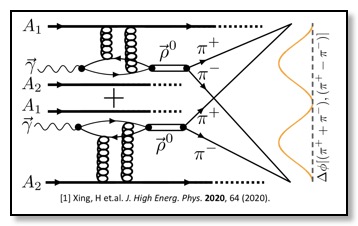
Isaac presented STAR measurements from diffractive photo-nuclear interactions in ultra-peripheral Au+Au and p+Au collisions at √𝑠𝑁𝑁=200 GeV and from U+U collisions at √𝑠𝑁𝑁=193 GeV. These measurements are used to measure the strong interaction radius of gold and uranium nuclei at high energy. He showed first measurements of the neutron skin of uranium measured at high energies and discussed the implications for experiments at the future Electron Ion Collider, where similar diffractive photo-nuclear interactions are an essential component in the planned physics program.
You can find his slides at this link.

Isaac presented STAR measurements from diffractive photo-nuclear interactions in ultra-peripheral Au+Au and p+Au collisions at √𝑠𝑁𝑁=200 GeV and from U+U collisions at √𝑠𝑁𝑁=193 GeV. These measurements are used to measure the strong interaction radius of gold and uranium nuclei at high energy. He showed first measurements of the neutron skin of uranium measured at high energies and discussed the implications for experiments at the future Electron Ion Collider, where similar diffractive photo-nuclear interactions are an essential component in the planned physics program.
You can find his slides at this link.
QuarkNet Masterclass 2022
May 05, 2022
On Saturday April 30 we organized our first do-i-dare-to-say-it "post-pandemic" QuarkNet Masterclass.
Almost 30 students from five high schools attended a pretty full day of lectures, demos, tours, and hands-on analysis of real data from the Large Hadron Collider at CERN. A special thank-you goes out to the US QuarkNet leadership for their support and the Rice Physics & Astronomy department who sponsored the lunches. I also appreciate NSCI's Dean Tom Killian, and his students for allowing us to tour their lab and showing the exiting physics at temperatures of about 0.00000001 (10^-9) K when we earlier in the morning talked about temperatures of 1000000000000 (10^12)K and in between had a lot of fun of some left-over liquid nitrogen which boils at 77K!
More details on this and other QuarkNet activities in my group can be found at this link. Here I will also post some more pictures, including the by-now traditional "hold-your-favorite particle" group photos.
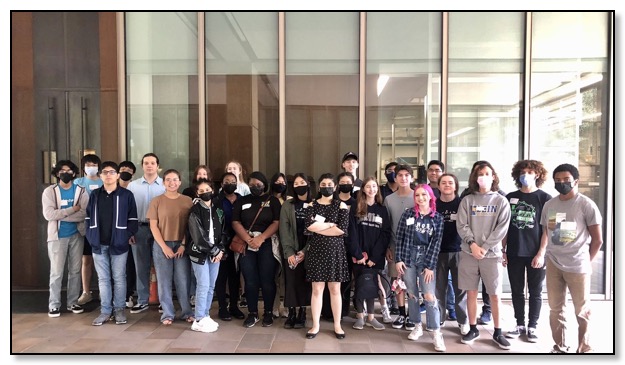
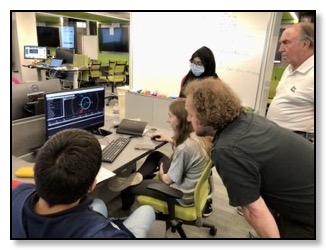
Almost 30 students from five high schools attended a pretty full day of lectures, demos, tours, and hands-on analysis of real data from the Large Hadron Collider at CERN. A special thank-you goes out to the US QuarkNet leadership for their support and the Rice Physics & Astronomy department who sponsored the lunches. I also appreciate NSCI's Dean Tom Killian, and his students for allowing us to tour their lab and showing the exiting physics at temperatures of about 0.00000001 (10^-9) K when we earlier in the morning talked about temperatures of 1000000000000 (10^12)K and in between had a lot of fun of some left-over liquid nitrogen which boils at 77K!
More details on this and other QuarkNet activities in my group can be found at this link. Here I will also post some more pictures, including the by-now traditional "hold-your-favorite particle" group photos.


QuarkMatter 2022 - Krakow, Poland
March 10, 2022
What a way to jump more than 2 years and talk about -again- about QuarkMatter. The 2022 edition, or rather the one that was originally planned for 2021. This year the meeting was able to take a few of us out from Zoom to "IRL". It allowed us to bring together again over coffee breaks, lunches, dinners, and the occasional beer the science and friendships that had been insulated by screens and microphones.
Anyways, a few points about this year's conference. First of, Zaochen Ye's hard work over the past years paid of beautifully in an excellent presentation on the first thermal dilepton based temperature measurement using STAR Au+Au data from the 2018 run at 27GeV and the 2017 run at 54GeV.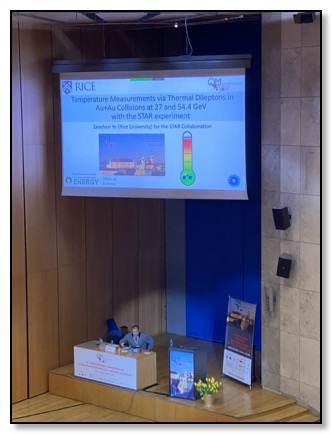
His results did not go unnoticed and reappeared in three more plenary overview presentations throughout the week. The 2022 QuarkMatter conference ended with a the invitation from the co-chairs of the 2023 QM meeting which will be held in ... Houston, TX! Yes, we look forward to seeing all our colleagues here in Houston in September 2023!
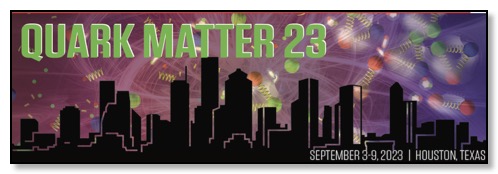
Anyways, a few points about this year's conference. First of, Zaochen Ye's hard work over the past years paid of beautifully in an excellent presentation on the first thermal dilepton based temperature measurement using STAR Au+Au data from the 2018 run at 27GeV and the 2017 run at 54GeV.

His results did not go unnoticed and reappeared in three more plenary overview presentations throughout the week. The 2022 QuarkMatter conference ended with a the invitation from the co-chairs of the 2023 QM meeting which will be held in ... Houston, TX! Yes, we look forward to seeing all our colleagues here in Houston in September 2023!

